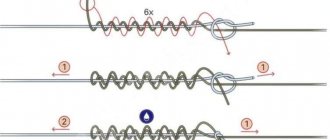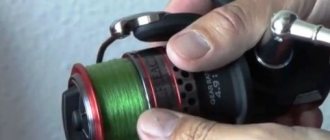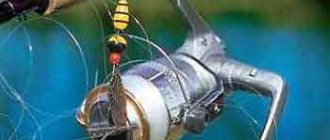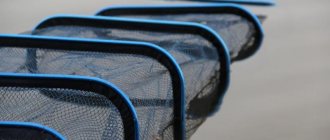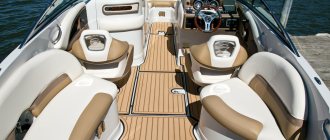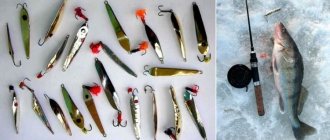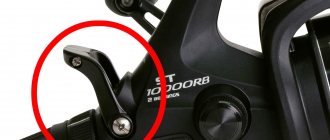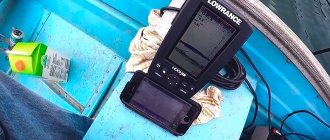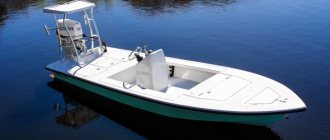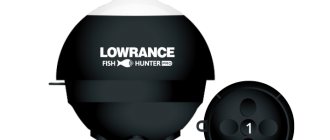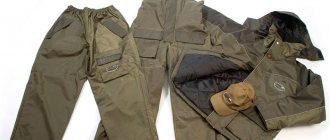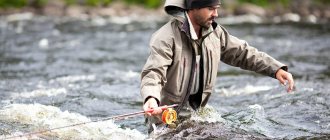Fishing lines rating
VyborExpert specialists studied more than 20 nominees with the largest number of positive reviews and removed the lowest quality products. To prepare the TOP, the products were tested and reviewed for ease of use, as well as versatility.
When selecting nominees, attention was paid to the following characteristics:
- Purpose;
- Material;
- Length;
- Diameter;
- Breaking load;
- Unwinding;
- Rigidity;
- Buoyancy;
- Color.
In order to avoid buying defects during the formation of the TOP, the ratio of price and quality of products was additionally taken into account.
The best spinning rods
Ice fishing line by type
For winter fishing, the same basic types of fishing lines are used as for summer fishing: monofilament lines, fluorocarbon lines and braided lines.
Monofilament lines
Monofilament fishing lines are the most popular and widely used type of fishing line for ice fishing. Monofilament fishing lines can be either transparent or painted in a wide variety of colors.
- Advantages of monofilament lseka:
- Good tensile strength with small line diameters
- Good elasticity and rigidity, eliminating overlaps
- Large selection in any fishing store
- Low price
Monofilament line is used when fishing with a jig, when trolling, catching with a winter float rod and as the main line for winter girders.
Fluorocarbon lines
Increasingly, anglers are using fluorocarbon fishing line for winter fishing.
- The main advantage of fluorocarbon is that it is transparent and invisible in the water, which is very important for delicate winter equipment, which is why fluorocarbon is often used for leaders.
- Fluorocarbon is abrasion resistant.
- Fluorocarbon has a too rigid structure. When fluorocarbon line is kinked during tying, it often becomes brittle.
- Fluorocarbon has low tensile strength compared to monofilament line and braided lines, so anglers have to use large diameter fluorocarbon lines, which is not particularly convenient for fishing.
- Fluorocarbon lines have a higher price.
It is not advisable to use fluorocarbon for light jigs. It is better to take a softer nylon. Sometimes fluorocarbon line is used for fishing at great depths and when fishing with spoons. The main use of fluorocarbon in winter fishing is the production of leashes on girders. It is too expensive to reel such fishing line on all the gear.
When choosing and purchasing a fluorocarbon frame, you need to be careful. Many dishonest manufacturers, under the guise of fluorocarbon, offer ordinary transparent nylon fishing line of dubious quality. To avoid getting into an unpleasant situation, you need to learn to distinguish a quality product from a fake.
True fluorocarbon does not burn because it is made from fluorocarbon. If you bring a burning match to the tip of such a fishing line, it will not melt like ordinary nylon, but will only begin to char. This simple test will help distinguish a fake from a real quality product.
Braided lines
Braided lines are not often used by anglers for ice fishing.
- Braided fishing lines have high tensile strength with a small thickness, which allows you to thin out the equipment.
- Braided lines have a low stretch coefficient, which ensures high sensitivity.
- Braided fishing line freezes heavily at sub-zero temperatures.
- Braided line, more often than other types of fishing line, gets tangled and tangled.
- Braided line is more visible in the water.
- The high price of braided fishing line compared to monofilament and fluorocarbon.
Because of all the above qualities, braided fishing line is very rarely used for winter fishing.
Fishing Braided Lines
Representatives of this group are known as “braid” - thin synthetic threads connected into a single cord. They have a special impregnation and, in some cases, an additional shell. Such options are characterized by increased strength. VyborExpert specialists included 4 nominees in the rating that received the maximum positive feedback from beginners and professional fishermen.
Mask Ultra x 4 110m d-0.10 orange
Fishing line is designed for fishing water bodies using ultra-light tackle. To make braided cords, 4 Super PE threads are used. Thanks to special impregnation, the surface is even and smooth, which improves sliding through the guides when casting. It can be used in ponds with rocky bottoms due to its wear resistance and resistance to damage.
Advantages:
- No “residual memory” effect;
- Use with light weight baits;
- Increased density and wear resistance to abrasives;
- Low friction.
Flaws:
- The orange color is washed out a little.
The fishing line is sold with a diameter from 0.06 to 0.2 mm, which is important for a light float fishing rod.
Kosadaka Super Line PE X4 150m light-green 0.20 mm
4-strand “braid” designed for spinning and feeder fishing. Thanks to its high breaking load - up to 12.2 kg, it allows you to catch large pike perch. Good abrasion resistance makes it possible to use it in difficult water areas with a large amount of snags, vegetation and shell rock.
In the production of the cord, the material used was modern polyethylene. Kosadaka is a good fishing line that is characterized by elasticity and high strength. It responds well to bites of any strength, this also applies to the use of a feeder. The product does not stretch, so it always remains sensitive.
Advantages:
- Practical marking – up to 150 m;
- Budget price;
- Suitable for fishing with wobblers at shallow depths;
- Good tensile strength;
- Can be used for feeder fishing.
Flaws:
- Slightly thick.
The light green tint is chosen by users who prefer visual control of the “braid” when fishing jigging. This allows you to estimate the current location of the bait.
DreamFish Silver Braid White 150 m 0.38 mm 20.5 kg
Line from an American manufacturer. When used, it creates the effect of the presence of a group of small fish. Predators give an immediate reaction and, when a really visible moving bait object appears, they immediately attack. The “braided line” is wear-resistant, which allows it to be used in jig fishing.
The "braid" does not stretch. The material that was used for its production is not sensitive to ultraviolet radiation, so the original color remains unchanged. Thanks to this, it has gained popularity among fans of twitching and fishing using spinners and spinners. The advantage of the tackle is its good casting range. Upon tactile contact, it is soft, slippery, and does not cut your hands when using a heavy bait.
Advantages:
- Suitable for both large and small fish;
- Relevant for jig fishing, as well as twitching;
- Does not stretch;
- UV resistant;
- Good casting distance.
Flaws:
- Over time it loses its original color.
DreamFish Silver Braid White is easily impregnated with additional compounds, which protects it from freezing when used in winter.
Shimano Technium 300m 0.285mm Black
One of the most popular models in the Shimano brand line. The “Technium Triple construction” technology is used in the production of the product, which allows for excellent resistance to abrasions and abrasion, a minimum elongation rate (only 12%) and increased wear resistance.
A special feature of Shimano Technium 300 m 0.285 mm Black is its three-layer structure, thanks to which this cord resembles both “braid” and monofilament. The surface of the thread is treated with a special coating, guaranteeing transparency and maximum smoothness. Thanks to the latter characteristic, the casting distance is improved.
Advantages:
- Suitable for feeder, float and spinning fishing;
- Highest wear resistance;
- Excellent range;
- Lack of memory;
- Several modifications depending on the type of fishing.
Flaws:
- Each modification has only one color.
Shimano Technium 300m 0.285mm Black is a good alternative to fluorocarbon that can be used as a shock leader.
The best winter fishing lines rating
The rating of the best types of fishing line for winter fishing includes various types of products from domestic and foreign manufacturers: Balsax Ice King - frost-resistant monofilament fishing line, characterized by good quality and low cost. One of the disadvantages of this model is the loss of strength at the joints and knots. Vicious Panfish Ice - high resistance to abrasion, low level of elongation and lack of memory, as well as the strength of the polymer material, make this type of fishing line indispensable for winter fishing. Power Pro Ice-Tec is an elastic, soft, highly sensitive winter line that guarantees excellent strength with a small diameter. A special coating imparts water-repellent properties to the material and reduces the formation of ice on the thread. Berkley FireLine Micro Ice Fused Original is a frost-resistant, transparent line from an American manufacturer designed specifically for winter fishing at sub-zero temperatures. Does not stretch, therefore retains sensitivity. The thread is completely invisible under water. Has high tensile strength. Berkley FireLine Micro Ice Fused Original is an invisible fluorocarbon filament that can remain strong in the thinnest thickness without memory effect. One of the best options for winter fishing line. Berkley Trilene 100 Percent Fluorocarbon Ice is a line with a hydrophobic composition that virtually eliminates the possibility of liquid freezing on it. Unique tear resistance allows this model to be used even when fishing for heavy fish.
PowerPro ICE-Tec is a durable braided line that is popular with ice fishing enthusiasts. Flexibility, knot strength, sensitivity and hydrophobicity - these qualities allow it to become one of the best types of fishing line. Momoi Pro Max Prestige is a Japanese type of monofilament fishing line that is strong and reliable during ice fishing. Its texture is soft and does not have a memory effect. Aquamarine fishing line is used very often for winter fishing. This is due to its improved strength characteristics, abrasion resistance and small diameter. In addition, it has an affordable price. Advice: when choosing the best winter fishing lines for fishing, the performance rating is very indicative, but you don’t need to focus only on it, you should also take into account your individual preferences.
Fishing monofilament lines
Monofilament fishing lines (also known as monofilament lines) are suitable for catching all types of fish. Nylon material is used in its manufacture. The editors of Vyborexperta.Ru included 3 nominees in this category in the rating, notable for their convenience, versatility and accessibility.
Berkley NanoFil
A unique development that combines increased strength and minimal elongation with a small diameter. Berkley NanoFil line is made up of a large number of fine Dyneema fibers that are joined by soldering. The tackle has both the characteristics of both “braid” and monofilament line.
Berkley Nanofil is knot sensitive. The thread slips a lot, so it can only be tied properly with 15-16 turns and careful tightening. With a smaller number, the monofilament will spread. When using the product, it is recommended to knit the Nanofil Khot, Double Albright, Double Albright and Carrot options. If you choose it incorrectly, then cliffs and shootings cannot be avoided.
Advantages:
- Sliding;
- Thin diameter;
- A light weight;
- Buoyancy;
- Off-season.
Flaws:
- May flake;
- It gets tanned in the cold.
When twisted on a spinning reel, the line speed slows down, despite the fact that the material is quite slippery.
Allvega ZDX Special Spin
An excellent choice for both professionals and novice fishermen. The Allvega ZDX Special Spin line is painted in a light gray shade, which makes it almost invisible in the water column. High levels of wear resistance, resistance to abrasive, and immunity to ultraviolet rays significantly increase the service life of the product.
Since the fishing line has no mechanical memory, the Allvega ZDX Special Spin is suitable for any type of fishing using reel gear. Its unwinding length is 100 m, so it is ideal for hunting with a spinning rod. The manufacturer offers a model of various diameters, ranging from 0.16 mm to 0.4 mm. The breaking load varies from 3.28 kg to 13.5 kg.
Advantages:
- High casting range;
- Stealth in water;
- Immunity to ultraviolet radiation;
- Lack of mechanical memory;
- Good abrasion resistance.
Flaws:
- It stretches.
When casting on a spinning rod, the line is harsh and is not suitable for fishing for pike perch.
Balsax Tarantula
Monofilament thread “Balsax Tarantula” is characterized by increased tensile strength, but at the same time has excellent stretch. This combination makes it an ideal choice when catching moving and even aggressive fish, since the line “works” as a shock absorber, preventing the fish from breaking the tackle.
The monofilament comes off the reel smoothly, without jerking. The line is practically not deformed. Thanks to the technologies used in its creation, the manufacturer has greatly increased the model’s abrasion resistance. Therefore, fishermen, even if they use it regularly, do not have to worry that the product will lose its properties.
Advantages:
- After casting it sinks almost immediately;
- Goes to the bottom in a straight line;
- Almost invisible in the water column;
- The bobbins can be interconnected;
- Budget.
Flaws:
- Not found.
Balsax Tarantula is well suited for winter ice fishing. It retains the properties declared by the manufacturer even in severe frost.
Types of fishing line for spinning
Companies specializing in the production of products for fishermen are constantly offering new products with improved characteristics. Understanding what is really suitable is not easy, especially for a novice amateur fisherman. When fishing, for example, with a spinning rod, three types of fishing line are used today.
Wicker
This thin cord, consisting of several strands, the raw materials for which are high-tech polymers, is often used as tackle. Naturally, this method of producing fishing line makes it possible to obtain a product with a high breaking load.
Braided fishing line for spinning
pros
- excellent strength;
- zero stretch;
- softness and lightness;
- high service life;
- ease of use and storage;
- variety of shades;
- no memory effect;
- resistance to ultraviolet radiation.
Minuses
- demands on the quality of the coil;
- the ability of fibers to fray when in contact with snags and stones;
- due to the lack of stretchability, there is a high risk of the spinning rod breaking when pulling out large fish;
- deterioration in performance due to stagnation of water between the fibers;
- poor frost resistance;
- high price.
In addition, there are no transparent cords. And the braided line, visible to predatory fish, can scare them.
It is recommended to use such a fishing line in cases where there is a high probability of snagging.
Fluorocarbon
This type of product appeared not so long ago, but has already become popular among fishermen. Line is produced from polyvinylidene fluoride by melting granules and squeezing the mass through dies of a certain diameter. The birthplace of the invention is Japan, which today occupies a leading position in the production of these products. Fluorocarbon is most often used as a material for leashes, but many fishing enthusiasts also use it as a base.
Fluorocarbon line
pros
- resistance to temperature influences;
- non-exposure to ultraviolet radiation and aggressive environments;
- resistance to drying out, wear and deformation;
- no memory effect;
- long service life;
- sufficient rigidity to ensure good bite transmission to the rod;
- high degree of transparency, ensuring the invisibility of the fishing line.
Minuses
- insufficient tensile strength;
- high ductility, leading to gradual weakening of nodes:
- high cost of branded products.
Monofilament
This type of fishing line is one of the most common and popular options. Nylon is used to produce equipment.
Photo of monofilament fishing line
pros
- small jq friction coefficient;
- smoothness, ensuring good sliding along the rings;
- stretchability, which allows you to smooth out the jerks of the caught fish;
- transparency, which provides good camouflage;
- budget cost.
Minuses
- less strength compared to a wicker counterpart;
- high tangles;
- loss of performance properties over time, which imposes a limitation on the service life;
- insufficient resistance to sunlight;
- the presence of a memory effect;
- poor sensitivity when fishing at long distances.
Video - About the features of different types of fishing lines
Fluorocarbon fishing lines
For the production of fluorocarbon fishing lines, chemical polymers are used, so the tackle is characterized by high wear resistance. It is completely invisible in the water, and therefore is traditionally used as a leading thread. The Vyborexperta.ru team included 3 nominees in the TOP who have proven themselves to be reliable and convenient.
Salmo Fluorocarbon
...I have been using this fishing line for several months. For beginners it is difficult to work with. The reason is the memory effect. Therefore, instead of a straight thread, there are solid curls between the rings of the fishing rod...
Expert opinion
New in the line of fluorocarbons from the Salmo brand. The fishing line belongs to the group of fast-sinking ones. Thanks to the almost complete absence of defects, it maintains the technical characteristics declared by the manufacturer for a long time. Salmo Fluorocarbon is completely colorless, therefore completely invisible in the water and is well suited for catching cautious fish, such as trout. Although the model is positioned as a summer one, it is also relevant for winter fishing.
Salmo Fluorocarbon is a good line for a fishing rod because it is highly sensitive to bites. This sinking thread allows you to successfully fish water bodies up to 4 m deep with a jig. The fisherman never loses contact with the bait. This fluorocarbon works well as a leader material, increasing the number of bites. It is also successfully used as the main option.
Advantages:
- Low stretch;
- Invisible in water;
- Accurate diameter calibration;
- Resistance to abrasives;
- Strong connecting nodes.
Flaws:
- Presence of mechanical memory.
Sufix Fluoro Tippet
A favorite among fluorocarbon lines. It belongs to the fast-sinking category. Among its characteristics, it is worth noting its high tensile strength and knot strength. This fluorocarbon is suitable as a leader material. Low light conductivity makes the thread practically invisible in the water column, allowing fishermen to catch excellent trophies among the most wary fish.
The increased stiffness combined with the lack of stretch improves the Sufix Fluoro Tippet's bite sensitivity. The load depends on the diameter of the fishing line: fluorocarbon can withstand fish weighing from 900 g to 5 kg. The fishing line is not saturated with water at all, so even with prolonged use it does not lose its strength.
Advantages:
- Comes off the reel easily;
- Unwinding – 25 m;
- High efficiency;
- Increased rigidity;
- Inextensible.
Flaws:
- Very tough.
Well suited as the main line when fishing on a feeder, if the body of water allows it.
Lucky John Fluorocarbon Hard
A new representative of Japanese-made fluorocarbon lines with a fairly high breaking load - up to 7 kg. The indicator is determined by the diameter of fluorocarbon. The declared range of cut sizes is from 0.148 to 0.31 mm, so the thread is successfully used both for catching calm fish on float rods and real trophy predators on a spinning rod. A model with a large cross-section is used for tying shock leaders.
The undoubted advantage of fluor is its invisibility in the water. The material used for its production has a refractive index of light almost identical to water, so the fish simply does not see the fishing line. In this regard, Lucky John Fluorocarbon Hard can be used to weigh down tackle. This does not cause stress to potential prey. Fluorocarbon options do not stretch and are abrasion resistant.
Advantages:
- Suitable for jig wiring;
- Unwinding length up to 30 m;
- Resistance to abrasives;
- Increased strength;
- Complete absence of mechanical memory.
Flaws:
- Poor extensibility;
- Rigidity.
If you plan to use ultra-light tackle, then you can choose a fishing line with a permissible breaking load of 1.8 kg.
Kinds
Monofilament
The following polyamide materials are used for the manufacture of modern fishing lines:
- Nylon. This material was invented by the American company DuPont in 1937. Monofilament line is transparent but still visible in water because its refractive index is 1.52 compared to water's 1.3.
- Capron. Nylon is similar in properties to nylon, as it was developed to produce a material that has similar characteristics, but would not interfere with the production of nylon. The credit for the invention of nylon goes to the German company IG Farben, which presented its products in 1952.
Advantages:
- accessibility and low cost;
- quite high strength;
- perfectly round cross-section;
- abrasion resistance;
- absolute indispensability in certain types of fishing (float, winter fishing);
- relative invisibility in water.
Flaws:
- extensibility;
- strength is lower than that of braided cord;
- fragility;
- exposure to external factors: temperature; ultraviolet radiation;
- presence of memory.
Monofilament fishing line is used in float fishing, winter fishing, and in some cases when fishing with a feeder and spinning rod.
Wicker
Braided lines were originally made from Dacron . It is now used as backing material in fly fishing. Dacron was replaced by Kevlar.
Modern braided lines are made from high modulus polyethylene . The material was invented in Holland and was called Dyneema. In the USA it is produced under license and is called Spectra. In Japan, this is done by Toyobo. Individual braided cords differ from each other in the number of fibers, weaving and impregnation methods. 3, 4 and 8-core cords are available. The latter have the most dense weaving, smoothness and with their help you can cast longer, but if damaged they are destroyed faster.
Advantages:
- low extensibility;
- lack of memory;
- high strength with small diameter;
- durability;
- resistance to external factors.
Flaws:
- high price;
- low abrasive resistance;
- visibility in water;
- the ability to absorb water and accumulate particles suspended in water;
- fast fading;
- the impossibility of achieving a circular cross-section and the relativity of diameter values;
- tendency to freeze when fishing at sub-zero temperatures;
- softness, making it very difficult to untangle beards.
Braided fishing line is indispensable for some types of spinning fishing (jigging, fishing with spaced rigs, twitching). Cords are also used when fishing with a feeder.
Fluorocarbon
Fluorocarbon was invented in 1971 in Japan. In our country, this material is called “fluoroplastic”.
Advantages:
- high wear resistance;
- resistance to any negative factors;
- the elongation is somewhat lower than that of braid, but higher compared to monofilament;
- rigidity;
- lack of memory;
- negative buoyancy;
- stealth in the water. Refractive index 1.42.
Flaws:
- high price;
- strength is less than that of monofilament fishing line;
- low knot strength.
Fluorocarbon is used as a leader material in spinning and feeder fishing, sometimes as the main line when fishing with a float and spinning rod, as well as in ice fishing.
A comparison of the properties of individual types of fishing line is given in Table 1.
Table 1 - Comparative characteristics of various types of fishing line
| Type of fishing line | Extensibility | Durability | Ability to absorb water | Resistance to external factors | Wear resistance |
| Monofilament | High | Low | Average | Low | Average |
| Wicker | Low | High | High | High | Low |
| Fluorocarbon | Average | High | Low | High | High |
How to choose a fishing line
To decide which fishing line is best for fishing, you need to pay attention to its type and diameter, as well as the type of fishing and the season of the year.
Type
There are 3 types of fishing lines. The first is monofilament (monofilament). Nylon is used for its manufacture. Its properties are determined by the type of technology used in manufacturing. This is a great choice for beginners.
The second type is braiding (multi-filament), which is thin threads woven using a special technique or a cord in a sheath.
The third type is fluorocarbon. It is made from chemical polymers. Flur is completely invisible in the water and is suitable for spinning rods and feeders as a leader material.
Type of fishing
For spinning rods, classic monofilament is traditionally chosen. But for jig fishing, only braided line is suitable, complemented by a fluorocarbon leader. For a float fishing rod, only monofilament with a fluor leash is used.
When feeder fishing, monofilament with a minimum elongation index is needed as the main line. Fluorocarbon is ideal for a leader. Ice fishing traditionally uses fluorocarbon line, but classic mono line can also be considered as an option.
Diameter
To hunt small, non-predatory fish, you need to take a thin fishing line. When fishing for a large trophy, such as carp, you will need a thread with a good tensile strength. When fishing in clear waters, you can settle on a thin product, but in an area with a lot of snags, driftwood or shell rock, you will need a thick cord.
Lines with a diameter of 0.1-0.2 mm are used as a leash for feeder or float fishing. Its length can reach 0.1-1 m. Varieties with a longitudinal cut of 0.2-0.4 mm are used as the main fishing line for feeder, float and other types of fishing.
Season
The fishing line can be all-season, i.e. universal, as well as summer and winter. The latter requires special attention. When purchasing, you need to choose threads marked “Winter” or “Ice”. The winter version has a smaller diameter, since in the cold season the fish moves slowly and can notice a thick fishing line. If you come across a large animal and it gets stuck in the hole, you will need to make an effort to remove it. Therefore, it is important to pay attention to strength.
If for the summer version elasticity is not so important, then the winter fishing line should remain flexible even in frosty conditions. The choice is influenced by frost resistance. The thread must have a special water-repellent coating that prevents it from icing. And the last requirement is extensibility. The higher this indicator, the better. There are no special requirements for the summer model, as well as for the all-season model.
The best feeder rods
Fluorocarbon line
The main distinguishing feature is “invisibility” in water. Fluorocarbon line has virtually zero refraction. Due to the properties of the material, it is resistant to abrasion.
Advantages:
- not visible in water
- abrasion resistant
- due to its rigidity, it can be used in thick diameters as a leash when fishing for pike
Flaws:
- higher price compared to monofilament line
- has a memory, can come off rings from a reel
- when comparing the same diameters with monofilament fishing line, it will always hold the breaking load less
Top 3 fluorocarbon lines:
DAM Tectan Superior FC 25m
Line DAM Tectan Superior FC 25m 0.12mm 1.3kg 2.9lb 293 RUR
Line DAM Tectan Superior FC 25m 0.12mm 1.3kg 2.9lb
Add to cart
DAM Tectan fluorocarbon line has almost the same refractive index as water, so it is virtually invisible to fish. The line has a minimum stretch coefficient and high knot strength. Immune to ultraviolet rays, i.e. practically does not age and does not lose its qualities. Cheaper than its analogues. Made of fast-sinking material, which allows you to use the lightest jigs.
Line Owner Tournament FC 50m
Line Owner Tournament FC 50m 0.140mm 326 RUR
Line Owner Tournament FC 50m 0.140mm
Add to cart
High quality fluorocarbon fishing line. It sinks very well because it has a high specific gravity. Good resistance to temperature changes. This fluorocarbon is also produced in Japan. Owner has been on the market for over 50 years and is famous for its quality products.
Sunline Siglon FC HG 50m
Line Sunline Siglon FC HG 50m 1.75/0.245mm 491 ₽
Line Sunline Siglon FC HG 50m 1.75/0.245mm
Add to cart
Sunline Siglon FC is a high-quality fishing line, available in 50 and 30 meter reels. Small unwinding lengths were chosen to reduce the price so that the buyer does not overpay for extra meters, which may not be in demand for a long time. Good abrasion resistance, often used for leashes when fishing for pike. A well-known Japanese company, preferred by many athletes. Due to these factors, this fishing line is very popular, even at a fairly high cost.
Which fishing line is better
The requirements for a fishing line depend on the current needs of the fisherman. When purchasing, professionals are interested in the properties of the material. This applies to such characteristics as mechanical memory, strength, rigidity, and invisibility in water.
To decide what is a good fishing line for a fishing rod, use the following tips:
- Are you using ultra-light gear? Pay attention to Mask Ultra x 4 110m d-0.10 orange.
- Kosadaka Super Line PE X4 150m light-green 0.20 mm has good abrasion resistance and high tensile strength.
- DreamFish Silver Braid White 150 m 0.38 mm 20.5 kg is suitable for jig fishing and twitching.
- The fishing line with the minimum degree of elongation is Shimano Technium 300 m 0.285 mm Black.
- Berkley NanoFil took the best properties of braid and monofilament.
- Allvega ZDX Special Spin is suitable for professionals and beginners.
- If you need to buy a budget model, but with good characteristics, you should take a closer look at the Balsax Tarantula fishing line.
- Salmo Fluorocarbon is recognized as an interesting new product in the line of fast-sinking fluorocarbons.
- A fluorocarbon line with increased rigidity is Sufix Fluoro Tippet.
- You can use Lucky John Fluorocarbon Hard to catch any fish - both calm and predatory.
Most fishing lines are characterized by versatility, so novice anglers will be quite comfortable fishing a body of water with the same type of fishing both on a float rod and on a spinning rod.
Recommendations for choosing fishing line
For those who have decided to try their hand at fishing for the first time and are faced with the need to purchase gear, you can choose a unified option, but experienced fishermen try to take into account many factors when preparing. What aspects should you pay attention to when buying fishing line?
- Hue . In this case, you need to take into account that the tackle should not scare away the fish, but the spinner should see it.
- Thickness _ This parameter is determined by the expected weight of the prey and the characteristics of the fishing rod.
- Type . As before, monofilament fishing lines remain the most popular.
- Purpose . The fishing line can be used as a main line or a leader line.
- Tensile strength . The thickness of the thread does not always determine its strength; much depends on the type and manufacturer.
- Extensibility . This indicator should be different in different situations.
How to choose a fishing line for spinning
A little more detail about the important properties of the fishing line.
Thickness
The biggest misconception of a novice fisherman is the desire to purchase the thickest, and therefore strongest, fishing line. However, it should be understood that a thicker product will become visible in the water. In addition, it can transmit the fisherman’s movements worse to the gear. There is no direct relationship between tensile strength and line thickness. This parameter is influenced by the type of material from which the equipment is made, as well as the quality specified by the manufacturer.
The most popular fishing line diameter: 0.2…0.25 mm. It is suitable for the most common types of fishing rods and for catching medium-sized fish. Of course, if you plan to get trophies in the form of catfish or large pike, such a fishing line will not be suitable.
Important! The lower the test of the rod, the thinner the fishing line should be selected for it.
Test, length and number of sections
Table. Test rod and line diameter.
| Rod test, g | Line diameter, mm |
| 1,5…12 | 0,12…0,16 |
| 7…30 | 0,25…0,3 |
You also need to consider the type of coil. The degree of filling of the spool affects the casting distance. The fishing location is important. In clear water and open reservoirs, you can use a thinner line than when fishing in thickets, where the possibility of snagging is not excluded.
Color
This factor is not the most important, but in some cases it is necessary to take it into account. For those who do not want to delve into the nuances, a translucent product is suitable.
Choosing the color of fishing line
However, if rig control or good camouflage is important to the angler, the following should be considered:
- for fishing in a pond overgrown with vegetation, a fishing line of brown, marsh or khaki color is suitable;
- when fishing in clear water on a sandy or pebble bottom, it is recommended to install transparent, bluish, grayish or beige fishing lines that blend as much as possible with the environment;
- if control over equipment is important to the fisherman, it is better to use red, yellow or white products;
- When fishing in poor visibility conditions, you can install luminescent fishing lines.
The color of fishing line at different depths
The choice of fishing line is largely determined by financial capabilities, since the best products are expensive. However, it is better to purchase high-quality gear once and subsequently enjoy good catches.
Video - How to choose monofilament fishing line for spinning
How to choose a winter fishing line according to the type of fishing
Winter fishing is very multifaceted. There are many different ways to fish from ice. Of course, fishing line is used everywhere, the choice of which is influenced by fishing conditions and the equipment and bait used.
The most common methods of winter fishing are:
- jig;
- sheer luster;
- float rod;
- zherlitsy.
In each case, when choosing a fishing line, you need to pay attention to the nuances of a particular fishing method, fishing conditions, bait used and the likely size of the fish.
The place where you plan to fish is of great importance. The most important in this case will be:
- depth at the fishing point;
- presence of current;
- water clarity;
- presence of snags and aquatic vegetation.
Experienced fishermen claim that the best nylon fishing lines for winter fishing are produced by Japanese manufacturers such as Shimano, Daiva and others. European companies also have good monofilament threads. Domestic and Chinese products are inferior in many respects, but are cheaper.
Fishing line for jig
Fishing with a jig involves fishing at depths of up to five meters. This is mainly used to catch small and medium-sized fish in places without current. Light jigs are used that weigh no more than a gram. In this case, you need a thin fishing line. Typically its diameter is 0.08–0.12 mm; athletes use a fishing line with a diameter of 0.05 mm.
Thin fishing lines can withstand up to a kilogram of tensile strength, but thanks to their shock-absorbing properties, they can also be used to bring out a more significant trophy. It is important for a jig to have no memory, otherwise the monofilament will quickly become unusable.
Fishing line for spoons
Fishing line for winter lure fishing is used with a diameter of 0.14 mm. It all depends on the predator that the fisherman catches. For perch, choose a fishing line with a thickness of 0.14–0.18 mm, for pike perch and pike – 0.22–0.30 mm.
For perch, choose a soft fishing line with good stretch. This fish has delicate lips and there will be a lot of escapes on hard tackle. For pike perch, on the contrary, you need a rigid monofilament thread that allows you to effectively cut through the bony mouth of a predator.
When fishing with heavy baits, the presence of memory in nylon has minimal effect on the reliability, performance and durability of the gear. But, if it is possible to choose a fishing line without this effect, then it is better to give preference to it.
When fishing with lures at positive temperatures, you can use braided cords with a diameter of 0.08-0.10 mm. Braided fishing line provides greater sensitivity of the gear and is more informative.
Line for float rod
Float winter tackle is used in a wide variety of conditions, so choosing a universal fishing line for a float fishing rod is almost impossible. Experienced fishermen fish in deep water with one rod, and in shallow water with another. The rigs for current and standing still are also different.
When fishing with winter float gear, transparent monofilament with a diameter of 0.12 to 0.20 mm is most often used, depending on the weight of the intended catch. For greater delicacy of gear, leashes from 0.06 to 0.12 mm are used. The length of the leash depends on the degree of activity of the fish. Active fish are caught with leashes 25 cm long, passive fish are caught with leashes 50 cm long.
For fishing at depth, special fishing lines are produced that sink quickly and have high rigidity. They are great for currents. For closed reservoirs, softer monofilaments are used. The diameter depends on the weight of the equipment used and the potential size of the fish.
In shallow water, it is important that the fishing line has minimal memory, is thin and moderately soft. Light baits are used here, and thin nylon provides better sensitivity of the tackle.
Fishing line for the girder
Most often, pike are caught using girders, so you shouldn’t go small with the diameter of the fishing line. Monofilaments with a thickness of 0.25–0.50 mm are usually used. There are no special requirements for them, other than strength. The use of a steel leash is advisable.
These same fishing lines are perfect for fishing with girders for pike perch, burbot and large perch. In this case, a leash is not needed, or fluorocarbon is used.
